
Top page ( correct Bohr model including helium )
Standard model is wrong.
Special (general) relativity is wrong.
(Fig.1) Neutron star is an illusion ? ← General relativity is wrong.

See LIGO gravitational wave is fake.
It is said that neutron star is a type of stellar remnant that can result from the gravitational collapse of massive star during supernova event.
Such stars are said to be composed almost entirely of very unstable neutrons.
For example, the neutron star PSR 1913+16 has 1.4 times solar mass (= 1.4 M ), and its radius is very short (= 10 km ).
So the mass density of this neutron star is as much as 1015 times that of the sun !
Even though this neutron star is unrealistically very dense, they insist, it is spinning as many as 17 times per second !
As you know, neutron itself is very unstable. They believe general relativity can give unrealistically strong gravity, which can keep this unstable state.
The important point is that the regular electromagnetic pulse is the ONLY experimental fact of this neutron star.
So if the interpretation of this pulse is changed by fatal paradoxes, the existence of neutron star becomes dangerous.
It is possible that some regular oscillaltion of some space matter ( not neutron star ) may cause this pulse.
The clear machanism of this radio radiation remains unknown.
(Fig.2) "21000" light-years away ! → Can you believe this result ??
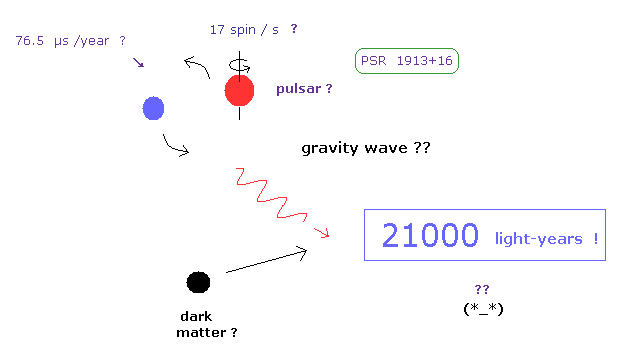
They insist gravitational waves were indirectly proved by observing the orbital period change of pulsar 1913+16.
General relativity predicts this orbital period decreases by 76.5 microseconds per year. ( ← very small ! )
They try to determine all parameters such as two masses of binary star, its spinning speed, orbital radius, and their speeds, based ONLY on the electromagnetic pulse and its change. ( ← impossible ! )
The problem is that this neutron star is as long as 21000 light-years away from the earth !
For example, it is impossible that we can know very slight historical change even on the earth 21000 years ago.
It is much more impossible that we can predict accurately all influences caused by unknown things such as dark matter, quantum fluctuations included in 21000 light-years path !
So this test of general relativity is very doubtful.
It is natural these very slight change is due to some space matter's oscillation along the extremely long way.
(Fig.3) General relativity is correct → we MUST believe "fantasy".

Gravitational waves are ripples in the curvature of spacetime that propagate as a wave, caused by some "mass".
If massive star emits gravitational waves, its orbital radius becomes shrinked, and orbital period is decreased with time.
They insist the observation of decreased orbital periods proved that general relativity is correct.
But as I said in Fig.2, this pulsar is as long as 21000 light-years away from the earth, so it is impossible to predict various other effects accurately in this extremely long light path.
In addition to this uncertainty, strictly speaking, gravitaional waves do NOT obey general relativity.
Because tensors expressing gravitational waves cannot be true tensors, as I explain later.
Furthermore, we need to artificially limit coordinate transformation (= TT gauge ) to get gravitaional waves.
And if general relativity is correct ( neglecting fatal paradoxes ), you MUST believe unreal 10-12 dimensional string ( M, F ) theory, faster-than-light inflation, black hole singularity, and dark energy (= violating energy conservation for expanding universe ! ).
(Fig.4) Detecting gravitational waves = Waste of much time and money.
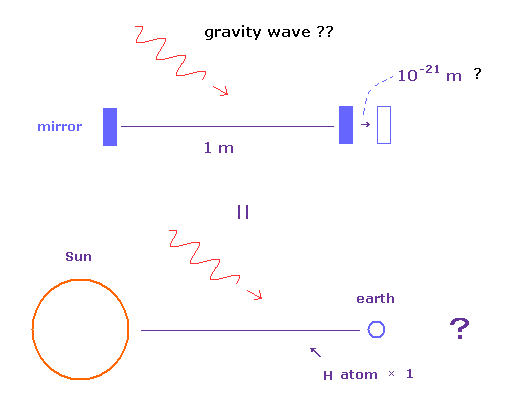
Gravitational waves are extremely weak.
They insist gravitational waves from sources such as supernova can change slightly the length of interferometer arm, which can be detected using light interference.
But this change of arm's length is very small, its changed length is as long as a single hydrogen atom between the sun and the earth.
Of course, we have to consider various other noises such as unknown dark matter, dark energy and quantum fluctuation.
So even if they insist gravitational waves are detected in the future, their results would be very doubtful.
They try to use much money to build very huge interferometer, or take advantage even of some satellites.
But as you feel, even if they observe this very slight change (= gravitaional wave ? ), this gravitational waves are completely useless forever.
How very weak gravitational waves can be useful for us ??
(Fig.5) Bohr's accelerating charge does NOT radiate. = "Mass" doesn't radiate gravity wave.

You may often see the explanation such as " Bohr's classical orbit is wrong, because its accelerating electron radiates and loses energy. "
But in fact, this explanation is completely wrong.
This mechanism is used for the extistence of gravitational waves, but unfortunately a single charge doesn't radiate !
It uses Poynting vector (= E × H ) as the energy flow.
This Poynting vector is equal to the change of the electric and magnetic energies in the vacuum.
This electric energy in the vacuum (= 1/2εE2 ) means the potential energies needed to gather minus (or plus) small charges to the sphere (= Fig.5 left-below ).
But a single electron is NOT made from smaller charges. ( A single electron is the smallest charge. )
It means the vacuum electric energy in a single electron is NOT energy, and Poynting vector itself is meaningless in this case. See also this page.
So this wrong explanation is a kind of brainwashing about Bohr model, I think.
(Fig.6) Observer's acceleration causes energy radiation and cancels gravitational wave ?

If a single accelerating charge radiates energy, and equivalence principle is right, we have to accept very strange phenomena.
There is a single charge at rest (= left upper ), which doesn't radiate energy.
But if some observer starts to accelerate, it is equal to the charge's accelerated motion from observer's viewpoint.
So this charge radiates energy or not, depending on the irrelevant observer's motion. This is clearly paradox.
( This effect is used in Unruh effect, and Hawking radiation. )
In the same way, we suppose some ( accelerating ) "mass" radiates gravitational waves (= energy ).
According to equivalence principle, if some observer accelerates, he can cancel out gravitational field at that point, which means gravitaional energy also disappears and is NOT conserved !
(Fig.7) Gravitational waves contradict energy momentum "tensor".

As a result, gravitational waves contradict energy momentum tensors predicted by general relativity.
So they must give up true "tensor" to describe gravitational waves. ( → "pseudotensor". )
( Actually there was long heated controversy on this subject. )
This is clearly self-contradiction.
(Eq.1) Covariant derivative and usual derivative.
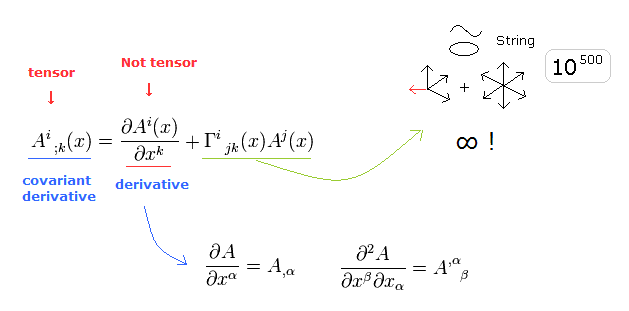
Notations are the same as this page.
Only in this page, we omit "c" first, and return it later.
Different from special relativity, usual derivative does NOT mean covariant vector in combination with some vector.
( Vector means it transforms like four-vector under coordinate transformation. )
As shown in Eq.1, covariant derivative includes very complicated Christoffel symbol (= Γ ), which causes serious divergence in the quantum field theory including general relativity.
So unreal string theory needed to be introduced to solve this problem.
In this page, usual derivative is denoted by ",". Covariant derivative is denoted by ";", as shown in Eq.1.
(Eq.2) Approximation by weak gravitational field

We have to rely on some approximation of weak gravitational field to get gravitational waves.
As shonw in Eq.2, the generalized metric tensor (= g ) can be divided into usual Minkowski tensor (= η ) and gravatational field tensor (= h ).
Due to very weak gravity, this "h" is supposed to be very small.
( Strictly speaking, this "h" cannot be "tensor" to get gravitational waves. )
(Eq.3)

Though "h" doesn't mean tensor, they approximately use Minkowski tensor η to change index position of "h".
This is strange.
(Eq.4) Approximation of Christoffel symbol Γ
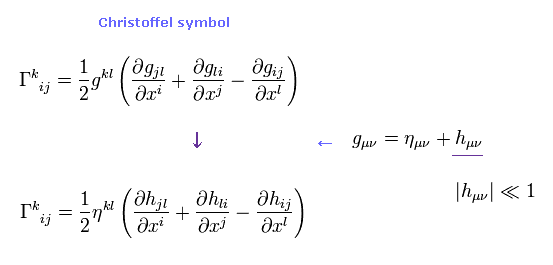
Neglecting second-order effect of "h", Christoffel symbol becomes, as shown in Eq.4
(Eq.5) Lorentz gauge condition of bar-h. = "artifical" restriction.
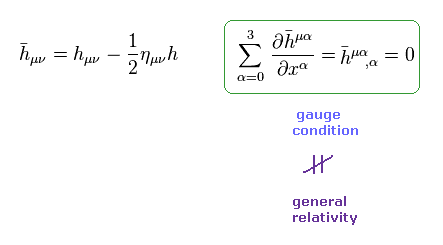
Here they define bar-h like Eq.5, and suppose this ba-h satisfies Lorentz gauge condition.
Restricting this metric tensor h to some condition means this theory doesn't apply in usual general relativity, because arbitrary coordinate transformation is forbidden by this condition .
So, again, strinctly speaking, gravitational waves are NOT equal to general relativity.
(Eq.6) Restiction of coordinate transformation.

Using the special condition of Eq.5 and approximation of Eq.2 and Eq.4, we get Einstein tensor (= G ) as
(Eq.7)

Solution of Eq.7 becomes
(Eq.8)
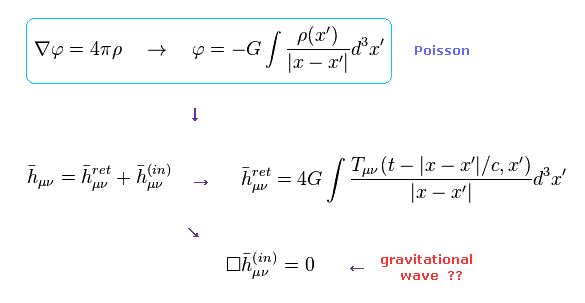
This solution includes usual gravity field (= upper ), and vacuum gravity field (= lower ).
The lower solution of Eq.8 means gravitational waves.
(Eq.9)

Plane wave solution of Eq.8 (= lower gravitational wave ) becomes as shonw in Eq.9.
In Eq.9, "aμν" is some constant, but tensor-like values ( not tensor, strictly speaking. )
(Eq.10) TT gauge = mathematical trick. Coordinate transformation is forbidden.
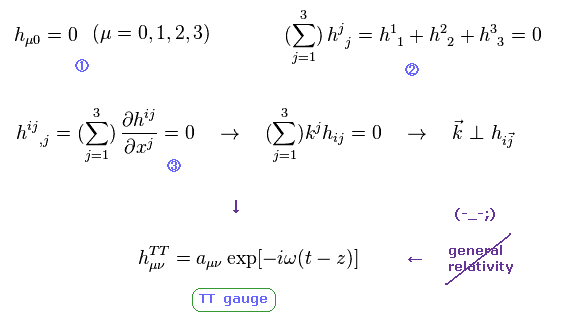
In fact, to get gravitational waves, we have to depend on some special three conditions, as shown in Eq.10.
In Eq.10 first, we exclude time-component tensor from gravitaional waves.
The second condition means traceless, which is only artifical definition.
The third is Lorentz gauge condition.
To satisfy all these three conditions, we must give up arbitrary coordinate transformation, so this TT gauge contradicts basic principle of general relativity.
(Eq.11) Traceless.

Traceless of "h" means h = 0.
So tesnors of bar-h and h become equal to each other, from Eq.5 and Eq.11.
This condition is introduced only for getting gravitational waves.
(Eq.12) Conservation of energy = violating general relativity !

As shown in this page, energy momentum conservation of general relativity is expressed using covariant derivative ( NOT usual derivative ).
But for gravitational waves to carry some conserved energy included in some space, we have to use usual derivative like classical mechanics (= Eq.12 right ).
Eq.12 right integral means energy is conserved in some space.
If this energy is not conserved, we cannot predict the effect of gravitational radiation from pulsar.
(Eq.13) Instead, "tensor" must be given up.

As you see in Eq.13, usual derivative (= , ) is clealy different from covariant derivative (= ; ).
So to satisfy Eq.13 (= energy conservation in some space ), we must admit the inconsistent fact that gravitational waves are NOT true tensor.
( As a result, it is called "energy-momentum pseudotensor". How do you think about this artificial rule ? )
(Eq.14)
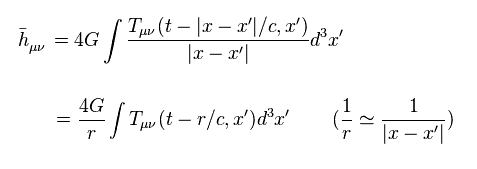
The solution of Eq.8 can be written like Eq.14.
(Eq.15)

Only T00 component (= time-time ) means "mass" (energy).
And Pk (= time-space ) component means momentum, which can be canceled out by choosing some center of mass.
(Eq.16)
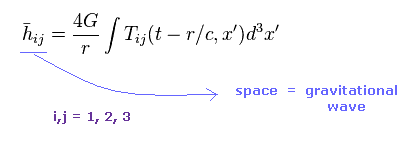
As a result, space-space component of "h" represents gravitational waves, they insist.
(Eq.17)
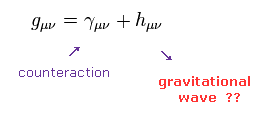
To get gravitational waves, we have to rely on some approximation.
Here we simply refer to approximate Isaacson equation of energy-momentum pseudotensor.
The generalized metric tensor is divided into "γ", and "h" like Eq.17.
This γ is supposed to include counteraction from gravitational waves.
(Eq.18)
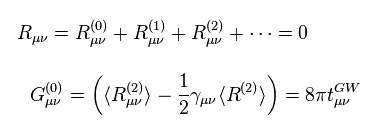
R2 means Ricci tensor including second-order approximation of metric "h".
After long calculation, we get approximate Einstein tensor of Eq.18.
(Eq.19)

Using TT gauge condition of Eq.10, we get energy-momentum pseudotensor of Eq.19.
This is called "Isaacson equation".
(Eq.20) Expanding Newton potential φ.
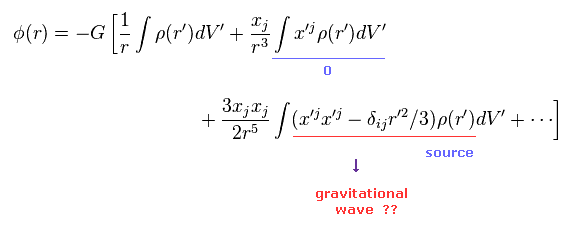
We can expand Newton potenial like Eq.20.
The second term (= dipole ) of the right hand becomes zero by choosing some center of mass.
So the source of gravitational waves becomes quadrupole moment (= third term ), which is different from electromagnetic wave.
(Eq.21) Quadrupole moment Q.

Using this quadrupole Q, pseudotensor of gravitational waves (= Eq.19 ) can be expressed as
(Eq.22)

So the "mass" source needs to be accelerating to radiate gravitational waves.
(Eq.23) Projection operator.

To turn some gravitational waves toward arbitrary direction, we use projection operator of Eq.23.
"k" means wave number vector of gravitational waves.
(Eq.24)
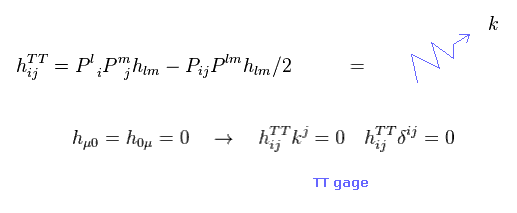
Gravitational pseudotensor "h", which direction is vector "k", can be expressed like Eq.24.
This pseudotensor "h" always satisfies TT gauge condition.
So this complicated mathematical formula is introduced Only for this artifical condition.
(Eq.25) Gravitational energy radiation per unit time.

Using projection operator, we turn tensor Q of Eq.21 toward radial direction.
And then we integrate them in all spherical surface.
This result becomes Eq.25.
This is the gravitational energy emitted per unit time.
(Eq.26) Two masses (= m ) exist at x = ± a.

To compute gravitational waves radiation emitted from binary neutron stars, first we consider the situation of Eq.26.
In Eq.26, two objects with mass "m" exist on "x" axis ( x = ±a ).
(Eq.27) Space-space peudotensor.
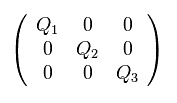
We suppose space-space pseudotensor Q like Eq.27.
Substituting Eq.26 (= 2 × m at x= ±a ) into Eq.21, we get quadrupole Q, as follows,
(Eq.28) Quadrupole.
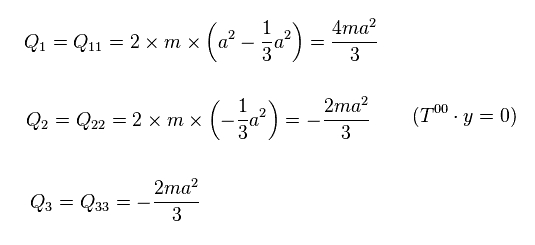
To emit gravitational waves, they need to accelerate.
We suppose these two objects are rotating on x-y plane with the angular frequency Ω.
(Eq.29) Rotation on x-y plane.

After the time of "t", this quadrupole Q (= pseudotensors ) transform like Eq.29.
(Eq.30) Tensor transformation = spin 2 ?

Eq.30 shows the transformation of Q11 component.
As shown in Eq.30, this Q transforms obeying the angular frequency of 2Ω, which has twice the original rotation frequency.
This is caused by tensor transformation (= R × 2 ).
So they insist gravitational field has spin "2".
But as you feel this "spin" has NO physical entity at all, it is just abstract "math".
(Eq.31) Results of all component.

Substituting the results of Eq.31 into Eq.25, we get
(Eq.32) Gravitational energy radiated from neutron star.

Eq.32 is the gravitational energy radiation emitted from binary neutron star per unit time.
Using the relation of Eq.32, we can compute the change of orbital period in pulsar.
Of course, we need to know all relevant parameters such as binary mass (= m1 and m2 ), frequency (= Ω ) and orbital radius (= a ) in advance, to compute orbital period.
Furthermore, pulsar 1913+16 is as long as 21000 light-years away from the earth !
So it is impossible to distinguish various other effects in this extremely long light path.
(Fig.7) "21000" light-years away → Very doubtful interpretation !


2013/10/22 updated. Feel free to link to this site.